
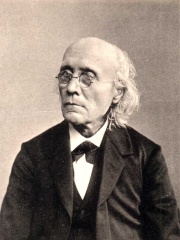
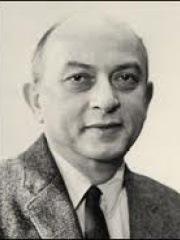
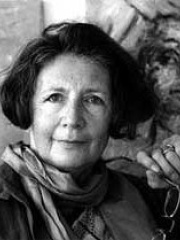
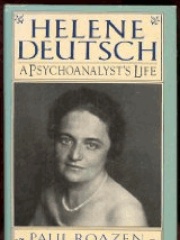

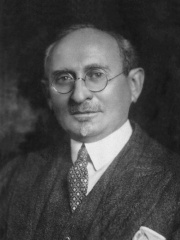
The Most Famous
PSYCHOLOGISTS from Poland
This page contains a list of the greatest Polish Psychologists. The pantheon dataset contains 235 Psychologists, 8 of which were born in Poland. This makes Poland the birth place of the 8th most number of Psychologists behind Switzerland, and Russia.
Top 8
The following people are considered by Pantheon to be the most legendary Polish Psychologists of all time. This list of famous Polish Psychologists is sorted by HPI (Historical Popularity Index), a metric that aggregates information on a biography's online popularity.

1. Kurt Lewin (1890 - 1947)
With an HPI of 75.66, Kurt Lewin is the most famous Polish Psychologist. His biography has been translated into 53 different languages on wikipedia.
Kurt Zadek Lewin or Kurt Tsadek Lewin ( LOO-in, lə-VEEN; German: [leˈviːn]; 9 September 1890 – 12 February 1947) was a German-American psychologist, known as one of the modern pioneers of social, organizational, and applied psychology in the United States. During his professional career, Lewin's academic research and writings focuses on applied research, action research, and group communication. Lewin is often recognized as the "founder of social psychology" and was one of the first to study group dynamics and organizational development. A Review of General Psychology survey, published in 2002, ranked Lewin as the 18th-most cited psychologist of the 20th century. During his career, he was affiliated with several U.S. and European universities, including the University of Berlin, Cornell University, MIT, Stanford University, and the University of Iowa.

2. Gustav Fechner (1801 - 1887)
With an HPI of 74.35, Gustav Fechner is the 2nd most famous Polish Psychologist. His biography has been translated into 56 different languages.
Gustav Theodor Fechner (; German: [ˈfɛçnɐ]; 19 April 1801 – 18 November 1887) was a German physicist, philosopher, and experimental psychologist. A pioneer in experimental psychology and founder of psychophysics (techniques for measuring the mind), he inspired many 20th-century scientists and philosophers. He is also credited with demonstrating the non-linear relationship between psychological sensation and the physical intensity of a stimulus via the formula: S = K ln I {\displaystyle S=K\ln I} , which became known as the Weber–Fechner law.

3. Solomon Asch (1907 - 1996)
With an HPI of 69.62, Solomon Asch is the 3rd most famous Polish Psychologist. His biography has been translated into 35 different languages.
Solomon Eliot Asch (September 14, 1907 – February 20, 1996) was a Polish-American Gestalt psychologist and pioneer in social psychology. He created seminal pieces of work in impression formation, prestige suggestion, conformity, and many other topics. His work follows a common theme of Gestalt psychology that the whole is not only greater than the sum of its parts, but the nature of the whole fundamentally alters the parts. Asch stated: "Most social acts have to be understood in their setting, and lose meaning if isolated. No error in thinking about social facts is more serious than the failure to see their place and function". Asch is most well known for his conformity experiments, in which he demonstrated the influence of group pressure on opinions. A Review of General Psychology survey, published in 2002, ranked Asch as the 41st most cited psychologist of the 20th century.

4. Alice Miller (1923 - 2010)
With an HPI of 69.14, Alice Miller is the 4th most famous Polish Psychologist. Her biography has been translated into 29 different languages.
Alice Miller (Swiss Standard German: [ˈmɪlər]; born Alicja Englard; 12 January 1923 – 14 April 2010) was a Polish-Swiss psychologist, psychoanalyst and philosopher, noted for her books on parental child abuse, translated into several languages. She was also a noted public intellectual. Her 1979 book The Drama of the Gifted Child caused a sensation and became an international bestseller upon the English publication in 1981. Her views on the consequences of child abuse became highly influential in the fields of child development, psychotherapy, and trauma. In her books she departed from psychoanalysis, charging it with being similar to the poisonous pedagogies. Miller systemically critiqued Freudian concepts like the Oedipus complex as an attempt to reinterpret or obscure the reality of child abuse. Core to Miller's writings was that the suppression of childhood truths (which perpetuates the psychological groundwork for violence, authoritarianism, war, mental illness, and systemic cruelty) is both a crime against humanity and a universal and enduring taboo against the true self, by privileging the authority of parents, tradition, religion, morality, or society over the needs of children. In a New York Times obituary, British psychologist Oliver James is quoted saying that Alice Miller "is almost as influential as R.D. Laing."
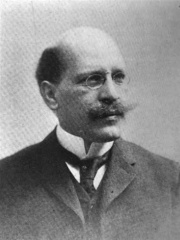
5. Hugo Münsterberg (1863 - 1916)
With an HPI of 66.91, Hugo Münsterberg is the 5th most famous Polish Psychologist. His biography has been translated into 30 different languages.
Hugo Münsterberg (; German: [ˈmʏnstɐbɛʁk]; June 1, 1863 – December 16, 1916) was a German-American psychologist. He was one of the pioneers in applied psychology, extending his research and theories to industrial/organizational (I/O), legal, medical, clinical, educational and business settings. Münsterberg experienced immense turmoil with the outbreak of the First World War. Torn between his loyalty to the United States and his homeland, he often defended Germany's actions, attracting highly contrasting reactions.

6. Helene Deutsch (1884 - 1982)
With an HPI of 63.19, Helene Deutsch is the 6th most famous Polish Psychologist. Her biography has been translated into 21 different languages.
Helene Deutsch (German: [dɔʏtʃ]; née Helena Rosenbach; 9 October 1884 – 29 March 1982) was a Polish-American psychoanalyst and colleague of Sigmund Freud. She founded the Vienna Psychoanalytic Institute. In 1935, she immigrated to Cambridge, Massachusetts, where she maintained a practice. Deutsch was one of the first psychoanalysts to specialize in women. She was a Fellow of the American Academy of Arts and Sciences.

7. Kurt Goldstein (1878 - 1965)
With an HPI of 61.39, Kurt Goldstein is the 7th most famous Polish Psychologist. Her biography has been translated into 19 different languages.
Kurt Goldstein (November 6, 1878 – September 19, 1965) was a German neurologist and psychiatrist who created a holistic theory of the organism. Educated in medicine, Goldstein studied under Carl Wernicke and Ludwig Edinger where he focused on neurology and psychiatry. His clinical work helped inspire the establishment of The Institute for Research into the Consequences of Brain Injuries. Goldstein was forced to leave Germany when Hitler came to power, because of his Jewish heritage. After being displaced, Goldstein wrote The Organism (1934). This focused on patients with psychological disorders, particularly cases of schizophrenia and war trauma, and the ability of their bodies to readjust to substantial losses in central control. His holistic approach to the human organism produced the principle of self actualization, defined as the driving force that maximizes and determines the path of an individual. Later, his principle influenced Abraham Maslow's hierarchy of needs. He was the co-editor of Journal of Humanistic Psychology.

8. Abraham Brill (1874 - 1948)
With an HPI of 58.84, Abraham Brill is the 8th most famous Polish Psychologist. His biography has been translated into 17 different languages.
Abraham Arden Brill (Austrian German: [brɪl]; October 12, 1874 – March 2, 1948) was an Austrian-born American psychiatrist who spent almost his entire adult life in the United States. He was the first psychoanalyst to practice in the United States and the first translator of Sigmund Freud into English.
People
Pantheon has 8 people classified as Polish psychologists born between 1801 and 1923. Of these 8, none of them are still alive today. The most famous deceased Polish psychologists include Kurt Lewin, Gustav Fechner, and Solomon Asch.
Deceased Polish Psychologists
Go to all RankingsKurt Lewin
1890 - 1947
HPI: 75.66
Gustav Fechner
1801 - 1887
HPI: 74.35
Solomon Asch
1907 - 1996
HPI: 69.62
Alice Miller
1923 - 2010
HPI: 69.14
Hugo Münsterberg
1863 - 1916
HPI: 66.91
Helene Deutsch
1884 - 1982
HPI: 63.19
Kurt Goldstein
1878 - 1965
HPI: 61.39
Abraham Brill
1874 - 1948
HPI: 58.84
Overlapping Lives
Which Psychologists were alive at the same time? This visualization shows the lifespans of the 8 most globally memorable Psychologists since 1700.

